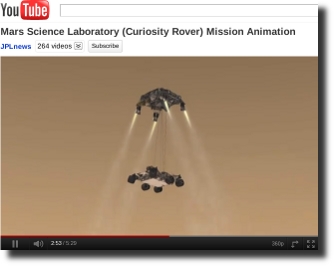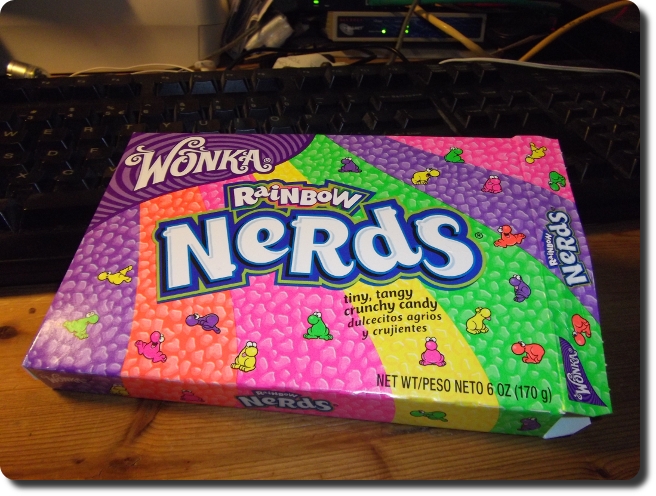
Thanks hun!
I like! ![]()
Glückliche Reise, Curiosity!
(Image Credit: NASA/JPL-Caltech)
Etwa eineinhalb Jahre nachdem der Phoenix Mars Rover für tot erklärt wurde hat die NASA heute mit dem Mars Curiosity Rover ein neues Gefährt auf die ca. neun Monate dauernde Reise zu unserem Nachbarplaneten geschickt. Der Rover soll dort im August 2012 ankommen und landen.
Wie man auf nebenstehendem Foto sehen kann, ist der neue Rover wirklich groß, vor allem wenn man ihn mit den früheren Gefährten vergleicht. Dementsprechend ist es eine große Herausforderung eine sanfte Landung auf dem Mars hinzubekommen.
Aufgrund der dünnen Atmosphäre des Mars sind Bremsfallschirme nicht sehr effizient und würden die Masse des Rovers kaum bremsen. Diese Masse ist auch der Grund dafür, dass Ballons, wie sie in früheren Missionen bei Spirit und Opportunity eingesetzt wurden, wenig erfolgversprechend sind, der Rover würde sie einfach zerplatzen lassen.
Die Animation der Mars Curiosity Rover Mission zeigt das ausgeklügelte System, das eine sichere Landung des Rovers auf dem Mars ermöglichen soll.Glückliche Reise, Curiosity!
Mobile Marketing Meets Security
 Stickers, like the one in the image to the right, can be seen in windows of branch offices of a bank here in Munich throughout the city.
Stickers, like the one in the image to the right, can be seen in windows of branch offices of a bank here in Munich throughout the city.
In case you don't know, this is a QR-code (Quick Response code), a 2-dimensional bar code, which can store an amazing amount of information.
Despite the fact that the code was invented in 1994 already, it became widely used since about 2007. As most mobile phones have a camera it was obvious to have a code to encode information like URLs in and a program that scans the code from the camera and hands it over to a web browser. This mobile tagging is quite popular and so the marketing department of the bank probably decided to use it to "go mobile". So it isn't much astonishing that the QR-code links to a mobile website of that bank.
QR-codes are also very fault tolerant, so one can turn it into very nice badges, which are still functional. The article »SnapTags: Will they kill QR codes?« of the folks over at webdesignerspot.com has some nice examples for this.
The problem however is that QR-codes aren't human readable at all. As the sticker of the bank is on the outside of the window it can be very easily replaced or modified and the link will lead one to a totally different site.

Above are three examples of QR-codes of websites. Do you think you can memorize one of the codes in a way that you can locate it again by heart from a larger set or even notice changes? I for sure cannot.
So what will happen if you replace or modify the QR-code of the bank in some highly frequented public locations to point to a website with critics about that bank or to a sex website? Will they notice? How long will it take them to notice? How big will the damage be?
How about if the link leads to a website installing some virus, trojan horse or key logger app on the mobile phones. It must be save, the bank has it on their window, so they guarantee for the security, right? Maybe this is some fancy banking promo app, so yes, people will install it.
Will the bank be held liable for damage?
Namensschilder für Polizisten
Ganz ehrlich: Ich verstehe die Aufregung nicht.
Nach einer ewigen Debatte wurden die Namensschilder für Polizisten jetzt in Berlin eingeführt und sofort heult die Polizeigewerkschaft rum, dass das alles schlecht für die Polizisten ist und dass die Schilder scharfkantig sind.
In Bayern wurde jetzt ein Gesetzesantrag der Grünen auf Namensschilder für Polizisten abgelehnt und auch eine unabhängige Beschwerdestelle für Polizeigewalt will der Innenminister Joachim Herrmann (CSU) nicht, denn :
Die Beamten dürften jedoch nicht unter Generalverdacht gestellt werden.
Verstehe ich nicht.
Eine Reihe unserer Politiker - auch Herr Hermann - will immer wieder - der Verfassung zum Trotz - die ganze Bevölkerung unter Generalverdacht stellen und überwachen und bespitzeln und da wird immer argumentiert, dass
Wer nichts zu verbergen hat, hat auch nichts zu befürchten.
Wieso sollte das bei der Polizei anders sein? Die haben doch nichts zu verbergen, sondern handeln zum Schutz der Bürger ... oder?
Facebook Spam by Image Tagging
The primary goal of any Social Network like Facebook is of course: to connect people. So, if you upload images of you and your friends to Facebook, needless to say there is a possibility to mark your friends in the photos and add their names. And of course this information is spread to your friends that got tagged and - depending on their privacy settings - also to their friends: "Bob was tagged in Alice's album" [1].
A few weeks ago I noticed a large increase of those messages regarding friends that are pretty active photographers and have a large network of photographers on Facebook. The strange thing about those messages was, however, that my friends didn't show up on those images.
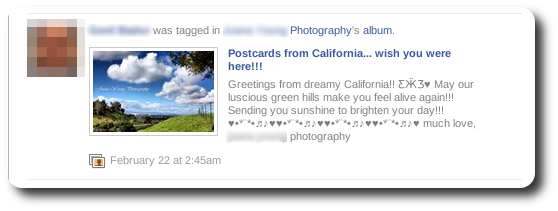
With the increasing number of those messages I first thought this was some Facebook group game, but then noticed that it was a kind of clever way to spread one's own images to a larger group, usually to all friends of friends. This is an enormous multiplier. Facebook limits the number of friends one can tag in an image to 30. If everyone of those 30 friends has 100 friends, you spread your image to about 3000 people's walls. Wow!
This is a feature with a potential too high for spammers not to notice. So it didn't take too long for a message like the following to appear on my wall:
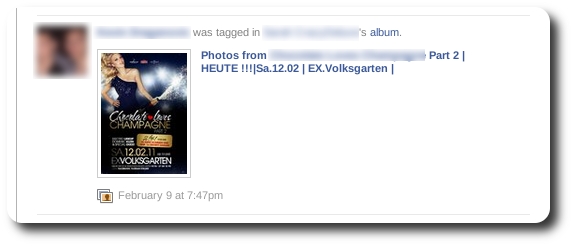
Going to the image page I could see it was indeed an event poster and 30 people were tagged. Looking at the images's album revealed this album contained that same image about 60 times and each of the images had another 30 people tagged.


Using the same assumption as above (100 friends per user) means that 60 * 30 * 100 = 180.000 messages were posted to people's walls. Even given the fact that probably a lot of those tagged "friends" share friends and thus the spammers did not reach 180.000 different people, even 10% ie. 18.000 different people is a really wide distribution. They didn't have to hijack computers or pay anything for that. Facebook provides the whole infrastructure.
Solutions
The only real solution to this problem has to come from Facebook. They have to change the way these messages are spread. Instead of having a global distribution setting for all those kinds of messages, there should be a setup similar to messages from other people's walls: if someone tags you in an image in their album the message is sent to your wall. The message should then have a "Share" option, which would allow you to spread those message to your (selected) friends.
Until then I would recommend to
- go to the page of the image and untag yourself. You can always remove tags of yourself from every image.
- terminate your friendship with that person or unlike the page if it is an event page or a fan page.
- report them to Facebook for being spammers.
If you don't want these kinds of messages ever to be spread to your friends go to
Account > Privacy Settings > Customize settings
Scroll down to "Things others share" and edit the setting of
"Photos and videos you're tagged in" to "Only me".
Season's Greetings 2010
A peaceful and recreative christmas time to all of you
and may your new year be full of healthiness, luck and success in everything you do!

Facebook and DNS - not friends
 DNS is a core technology of the Internet since 1987, when P. Mockapetris published RFC 1024: "Domain Names - Concepts and Facilities". DNS-Servers all over the Internet translate names to addresses, serve Mail eXchanger information, LOCation data and - amongst others - since 2000 there is RFC 2782: "A DNS RR for specifying the location of services (DNS SRV)".
DNS is a core technology of the Internet since 1987, when P. Mockapetris published RFC 1024: "Domain Names - Concepts and Facilities". DNS-Servers all over the Internet translate names to addresses, serve Mail eXchanger information, LOCation data and - amongst others - since 2000 there is RFC 2782: "A DNS RR for specifying the location of services (DNS SRV)".
In February 2010 Facebook opened up their WebChat via XMPP so you can have it in your instant messaging client. XMPP uses DNS SRV RRs to find servers. If your XMPP account is joe@im.example.com (yes, it looks like an email address) clients would query the DNS for a SRV RR of
_xmpp-client._tcp.im.example.com
and the answer would either be NXDOMAIN, if no such service / resource record exists or something like
_xmpp-client._tcp.im.example.com. 300 IN SRV 100 100 5222 chatserver.example.com.
The client would then connect to the host chatserver.example.com on port 5222. If no SRV records exists the client would try im.example.com as a host and the default port 5222.
Zillions of XMPP servers all over the Internet work that way.
Now let's take a look at Facebook. All chat addresses have the form user@chat.facebook.com (as mentioned on "Facebook Chat. Everywhere"). So, clients do a DNS SRV lookup for chat.facebook.com:
$ dig _xmpp-client._tcp.chat.facebook.com. srv ;; ->>HEADER<<- opcode: QUERY, status: NOERROR, id: 34540 ;; flags: qr aa rd ra; QUERY: 1, ANSWER: 1, AUTHORITY: 1, ADDITIONAL: 0 ;; ANSWER SECTION: _xmpp-client._tcp.chat.facebook.com. 30 IN CNAME chat.facebook.com.
Woopsie! A NOERROR response with an answer type (CNAME) undefined for a SRV query. And it doesn't even make sense, either.
Using a different DNS cache server (BIND instead of djbdns) even gives:
;; ->>HEADER<<- opcode: QUERY, status: SERVFAIL, id: 50544
I guess most clients can handle that, at least pidgin can. Nevertheless it is another example how Facebook is messing up their DNS and also their chat. And I thought it couldn't get worse as their XMPP server don't support SSL/TLS for secure communication.
★ Oh, for a pro! ★
Sintel
«Sintel» ist ein als OpenMovie unabhängig produzierter Kurzfilm und das Ergebnis des Projekts Durian der Blender Foundation. Durch die Unterstützung des Netherlands Film Fund konnten mehr Künstler und ein längerer Produktionszeitraum, als ursprünglich gehofft, finanziert werden. Sieht man Film, hat sich dies auf jeden Fall gelohnt!
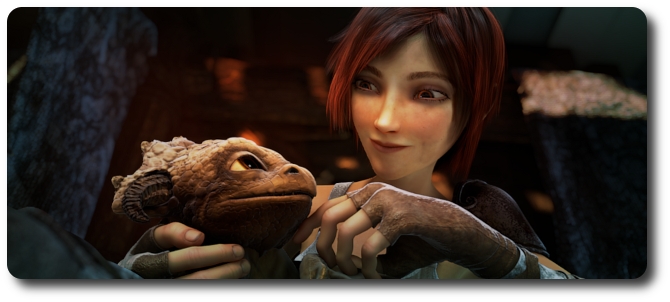
Wie bei den vorangegangenen Projekten Orange (Elephants Dream), Peach (Big Buck Bunny) und Apricot (Yo Frankie!) fliessen die Ergebnisse der Entwicklung wieder an blender zurück.
Der Film steht als Download in verschiedenen Formaten und Größen per HTTP oder Torrent inkl. Untertitel zur Verfügung. Man kann ihn sich auch bei youtube.com als Stream im Browser ansehen (auch 720p und 1080p HD).

